

 |
 |
 |
 |
 |
 |
 |
Our solar system consists of our sun and all the celestial objects that orbit around it. Most of us are only familiar with the eight planets, the ex-planet Pluto and the asteroid belt, but there are several regions beyond the reaches of Pluto's orbit that are still technically a part of our solar system. Among these are the Kuiper Belt, the Scattered Disc and the Heliopause. Since we've already explored the sun in some detail, let's take a look at the different regions of our solar system. But before we can go much further, we need to know what a planet actually is. The definition of the word "planet" has been in a state of some ambiguity up until 2006, when the International Astronomical Union came to an official consensus on the meaning of the word. According to the IAU, a celestial object must meet three criteria to be considered a planet: It must orbit a star, it must be large enough for its own gravity to make it spherical, and it must have "cleared the neighborhood" of its own gravity, which, put simply, means that it must be gravitationally dominant, and there are no other bodies of comparable size other than its own satellites nearby. So, Earth fits this example because the only body nearby that is of comparable size is the moon, and the Earth is quite clearly gravitationally dominant over little Luna. However, the ex-planet Pluto does not meet these criteria, because it is not gravitationally dominant over Charon. Pluto, like several other objects in the Solar System, such as Ceres in the Asteroid Belt, is considered a Dwarf Planet, because it still orbits a star and is still large enough for gravity to make it spherical. So, with that out of the way, let's explore the Solar System!

The Inner Solar System consists of the four terrestrial planets and the Asteroid Belt. The planets in the inner Solar System are composed largely of refractory minerals, such as the silicates which form their crusts and mantles, and metals such as iron and nickel, which form their cores. All of them, with the exception of Mercury, have significant enough atmospheres to produce weather conditions, and they have very few to no moons. These planets are called the terrestrial planets because of their rocky composition, and the fact that they are the group to which Earth belongs.
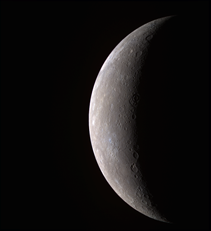
At .4 AU, Mercury is the planet that is the closest to the sun, and is now the smallest planet in the Solar System as of 2006. Mercury's atmosphere is almost non-existent, and consists mainly of atoms blasted off its surface by solar winds. It has no moons, and is characterized by its heavily cratered surface.
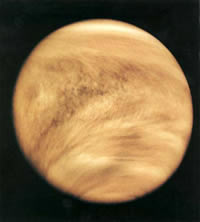 Venus
VenusFor a long time, Venus was thought to be Earth's sister planet. They are roughly the same size, with Venus being slightly smaller, and when viewed through a telescope it appears to have a cloudy atmosphere similar to Earth's. But Venus is actually one of the most violent and poisonous places in the entire Solar System. Its atmosphere is composed almost entirely of carbon dioxide, and the the greenhouse effect caused by that gas keeps the surface temperature at a staggering 400 degrees Celsius, making Venus the hottest planet, even hotter than Mercury! There is evidence of a great amount of seismic activity beneath the surface of Venus, and it is thought that volcanic activity continues to feed its choking atmosphere.
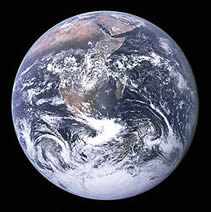
Situated 1 AU from the Sun, Earth is the 3rd planet in the Solar System and one of two terrestrial planets to have a moon. Our moon, whose name actually is Luna, is the first extraterrestrial body to be visited by human beings, and is the largest natural satellite among the terrestrial planets. Earth is the only planet in the known Universe that we know supports life. Though there is evidence that other planets like Mars once supported microscopic life forms, Earth is the only planet that has allowed them to continue living. The secret to Earth's success is that it is the only planet in the Solar System to contain liquid water. Though frozen water has been found at the polar caps of Mars, Jupiter's moon Titan and even our own moon Luna, we have determined that for life to exist on a planet, especially advanced life like humans, it must have access to some form of liquid water. Earth is also the only planet in the Solar System where plate tectonics is known to occur.
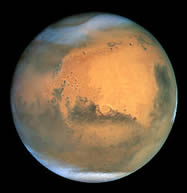 Mars
MarsMars is smaller than both Earth and Venus, and is the only other planet that has been extensively explored. Its many deep valleys and the large amounts of iron oxide in its crust have led scientists to believe that there was once a great deal of liquid water on its surface. Mars also has several geological features that far outshine those on Earth. The enormous volcano Olympus Mons (literally "Mt. Olympus" in Latin) is almost three times as tall as Mt. Everest, and is the largest volcano and mountain in the entire solar system. The canyon system at the planet's equator, the Valles Marineris (Latin for the Valleys of Mariner, named after the spacecraft that discovered them), is ten times longer and six times deeper than the Grand Canyon on Earth, and is also the largest canyon system in the Solar System. Mars has two small natural satellites called Phobos and Deimos, which are thought be captured asteroids.
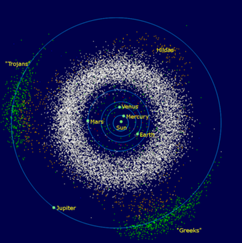
The Asteroid Belt is a band of possibly millions of objects ranging from less than a meter to over 1000 km in diameter. They are thought to be the remnants of the Solar System's formation that failed to coalesce because of Jupiter's gravitational interference. The smallest objects in the Belt, those that have a diameter of less than 10 meters, are called Meteoroids. Ceres is the only object in the Belt to be labeled something other than an asteroid, as it meets the 2006 IAU criteria for classification as a Dwarf Planet.
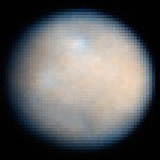
Two other objects in the Belt, Vesta and Hygieia, may also be classified as Dwarf Planets if it is discovered that they have achieved hydrostatic equilibrium.
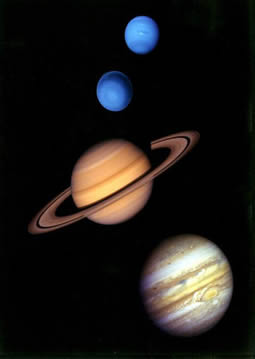
The outer Solar System is home to the four gas giant planets, often called the Jovian Planets, and their large moons. Because Neptune and Uranus are mainly composed of ice, some astronomers suggest that they belong to their own category, the ice giants. Many short term comets also orbit this region. The planets in the outer Solar System collectively make up 99% of all the mass known to orbit the Sun.
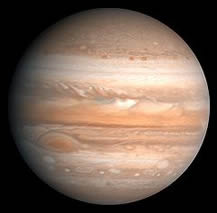 Jupiter
JupiterJupiter is the largest planet, and the largest object orbiting the Sun. It is so large that its mass is still 2.5 times larger than the mass of all the other planets put together. Composed largely of hydrogen and helium, Jupiter's internal heat creates several semi-permanent cloud features, including the Great Red Spot, which is actually a huge storm system that is larger than the Earth! Jupiter has 63 known satellites, the largest of which are Io, Calliston, Europa and Ganymede. These four moons share some characteristics with the Terrestrial Planets, such as vulcanism and internal heating. Ganymede, the largest of Jupiter's moons, is also the largest satellite in the Solar System and larger than Mercury.
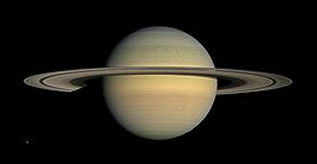
Saturn is the least dense planet in the Solar System. Though it is 60% as large as Jupiter, it is less than a third as massive. Saturn's atmosphere is also primarily hydrogen and helium. If there were an ocean on Earth big enough to fit Saturn, it would float. Though almost all of the Jovian planets have some sort of ring system, Saturn's is the largest and most extensive. Its rings are composed mostly of water ice particles that only reach a few meters in diameter at the largest. Saturn has 62 confirmed satellites, the most prominent being Titan and Enceladus. Titan is larger than Mercury, and is the only moon in the Solar System to have a substantial atmosphere.
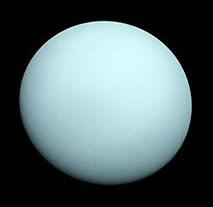 Uranus
UranusUranus is the first of the so-called "ice giants." It is the lightest of all the Jovian planets weighing in at a mere 14 Earth masses. Due to its relatively cold core, it radiates very little heat into space. Uranus is unique in that it roates on its axis at almost a 90-degree angle to the Sun. It posesses 27 known satellites, the largest of which are Titania, Miranda, Oberon, Umbriel and Ariel.
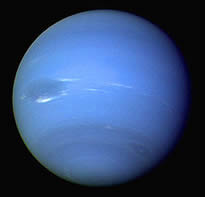
As of the 2006 decision to classify Pluto as a Dwarf Planet, Neptune is the farthest planet out from the Sun. The only other "ice giant" aside from Uranus, Neptune is slightly smaller and more massive, making it more dense. Neptune has 13 confirmed satellites, the largest of which is Triton. Triton has exhibited evidence of geologic activity, with geysers spewing out liquid nitrogen. It is also the only moon in the Solar System with a retrograde orbit, meaning that it revolves around Neptune in the opposite direction that the planet rotates. Beyond Neptune is a region called the Trans-Neptunian Region, a largely unexplored region that appears to consist almost entirely of smaller worlds a fifth the size of Earth.
The Kuiper Belt is a great ring of debris that is smaller than the asteroid belt and mostly composed of ice. There are many dwarf planets inhabiting the Kuiper Belt, the most notable of which is Pluto. Since being stripped of its status as a planet in 2006, Pluto is now the largest object in the Kuiper Belt. Other dwarf planets such as Eris, Orcus and Haumea also inhabit this region. Overlapping the Kuiper Belt is a region called the Scattered Disc, which is a ring of debris from which it is thought that short range comets originate. Not long ago, both the Voyager 1 and Voyager 2 spacecraft launched in the 1970s passed through the Kuiper Belt.
At a distance some 100 AU from the Sun, the solar wind collides with the interstellar wind, a stream a charged particles in the interstellar medium. This impact point, called Termination Shock, is the point when the solar wind becomes more violent and forms a sort of bubble around the Solar System called the Heliosheath. The edge of this shield is called the Heliopause, and it is the point when the solar wind ceases and interstellar space begins. To date it has been reported that Voyager 1 and Voyager 2 had both cleared Termination Shock and had entered the Heliosheath.
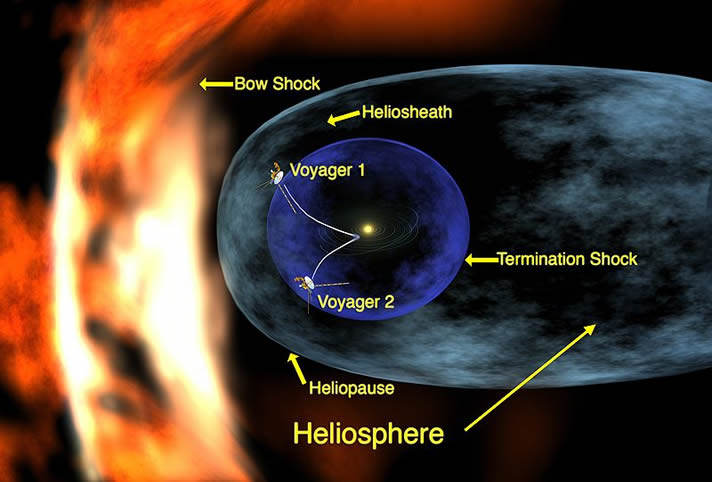
The Oort Cloud is a hypothetical ring of about a trillion icy particles that extends anywhere from 1 to 2 light years away from the sun. It is the region of space where long term comets are thought to originate.
Beyond the Oort Cloud is interstellar space, where our nearest stellar neighbor is still at least 2 light years away. Astronomers have detected 415 planets orbiting alien stars as of 2009, though closer observation has shown that these solar systems are nothing like our own. There are some planets that orbit so close to their star that their atmospheres have been blasted away completely. Many of the planets detected have masses roughly comparable to Jupiter, though some planets smaller than Earth have been found. Based on the nature of these extrasolar systems, it is impossible to tell whether any of the planets there even come close to resembling anything we are currently familiar with. It's possible that there are planets composed of elements like neon or carbon. Very few extrasolar planets that have been observed have the potential to contain life as we know it. A planet that orbits the nearby red dwarf star Gliese 581 (imaginitively named Gliese 581d) is toward the outer edge of what is called the "habitible zone" of its star's orbit, meaning that it is fairly cold, but astronomers believe it could still support life if it had a significant covering of greenhouse gasses. Click here to continue our short tour of the Universe and explore some of the different things we can find in our entire galaxy!